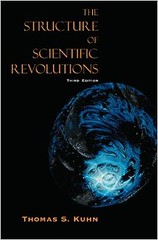'The Structure of Scientific Revolutions' is a book concerned with the history and philosophy of science. It was a book which created widespread discussion among scientific - and nonscientific - communities regarding the practice of science. Since it was first published in 1962, this book has triggered an ongoing assessment of the way science works. As with any theory unsettling the concurrent beliefs, this book was also criticized for its content by some scientists and philosophers; and in the second edition in 1970, Thomas S. Kuhn, the author of the book, had to write a postscript to discuss these concerns.
In this book, Kuhn does not believe in the widespread belief that science proceeds by continuous accumulation of data and theories. Instead, Kuhn believes that science proceeds by long periods of normal science separated by revolutionary periods where two theories exist simultaneously competing with each other. Any of these two theories can get acceptance in the wider science community. Many times newer theory fails the close scrutiny. At other times, the newer theories solve many new problems and get wide acceptance. This is termed as a paradigm shift, a phrase which is very common now. These shifts do not happen that easily which is necessary for the practice of normal science.
Kuhn also describes the practice of normal science. After a paradigm has emerged, scientists who have given so much time learning and applying that paradigm, normally stick to that for the whole of their life. In that case, they do puzzle-solving i.e. applying the paradigm to the problems which seem solvable by that paradigm. Sometimes few problems emerge which could not be solved by the paradigm. Then the paradigm might be tweaked to accommodate the solution of that problem. Sometimes few puzzles emerge which could not be solved by the existing paradigm. These are called anomalies which necessitate the emergence of a new paradigm. The new paradigm should be able to solve new puzzles as well as explain the data which was earlier explained by the older paradigm.
The examples that Kuhn use in this book to prove his point are varied and taken from multiple disciplines of science. He invokes Dalton's law of combination in fixed proportion to show that the mixture of alcohol and water could not be considered a compound. Similarly, the discovery of oxygen was not agreed upon by chemists readily. He argues that the Ptolemaic science was so different from the Copernican model that it could not be a case of accumulation of knowledge. Newton's dynamics was very much different from Einstein's theory but Newton's laws of motion and theory of gravity were able to explain many natural phenomena. It was derived as a special case of theory of relativity. This is also a practice where an older theory is proved to be a special case of a newer theory.
Kuhn also questions the teaching of science. In the textbooks of science, this paradigmatic evolution is never taught. In fact, the current paradigm is taught in such a way that older theories seem to give way to the current one. He uses Darwin's theory of evolution to drive home this point. Kuhn says that according to Darwin's theory higher organisms evolved from the lower ones going down to the single-celled organisms. So if we travel across time we will see these multiple levels of evolution. The science can be taught in much the same way - different paradigms can be the different levels of scientific evolution. Kuhn says that no doubt the greatest paradigm shifts are normally brought by young scientists who are not immersed deep in a paradigm or yet to embrace a paradigm to a point of no return.
Kuhn's theory was criticized by many because of its alleged dramatization of scientific revolutions and radical approach taken towards the revolutions. According to the critics, the paradigm shifts also occur during the Kuhn's period of normal science. Kuhn says that paradigms are incommensurable i.e. the old paradigm cannot be proven by the rules of the old one and vice versa. While answering criticism of incommensurability, Kuhn says that the same term can have a different meaning in different paradigms i.e. it all boils down to the language. Kuhn says that it is difficult to have a language which can be used to compare the two paradigms impartially.

